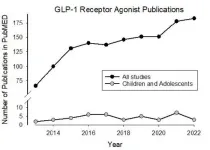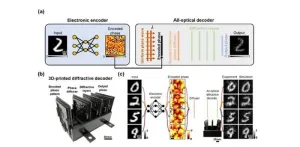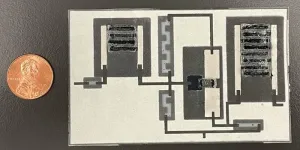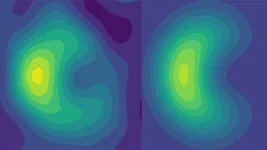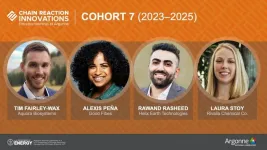Golden rules for building atomic blocks
2023-08-29
(Press-News.org)
National University of Singapore (NUS) physicists have developed a technique to precisely control the alignment of supermoiré lattices by using a set of golden rules, paving the way for the advancement of next generation moiré quantum matter.
Moiré patterns are formed when two identical periodic structures are overlaid with a relative twist angle between them or two different periodic structures but overlaid with or without twist angle. The twist angle is the angle between the crystallographic orientations of the two structures. For example, when graphene and hexagonal boron nitride (hBN) which are layered materials are overlaid on each other, the atoms in the two structures do not line up perfectly, creating a pattern of interference fringes, called a moiré pattern. This results in an electronic reconstruction. The moiré pattern in graphene and hBN has been used to create new structures with exotic properties, such as topological currents and Hofstadter butterfly states. When two moiré patterns are stacked together, a new structure called supermoiré lattice is created. Compared with the traditional single moiré materials, this supermoiré lattice expands the range of tunable material properties allowing for potential use in a much larger variety of applications.
A research team led by Professor Ariando from the NUS Department of Physics developed a technique and successfully realised the controlled alignment of the hBN/graphene/hBN supermoiré lattice. This technique allows for the precise arrangement of two moiré patterns, one on top of the other. Meanwhile, the researchers also formulated the “Golden Rule of Three” to guide the use of their technique for creating supermoiré lattices.
The findings were published in the journal Nature Communications.
There are three main challenges in creating a graphene supermoiré lattice. First, the traditional optical alignment strongly depends on the straight edges of graphene, but it is time-consuming and labour-intensive to find a suitable graphene flake; Second, even if the straight-edged graphene sample is used, there is a low probability of 1/8 to obtain a double-aligned supermoiré lattice, due to the uncertainty of its edge chirality and lattice symmetry. Third, although the edge chirality and lattice symmetry can be identified, the alignment errors are often found to be large (greater than 0.5 degrees), as it is physically challenging to align two different lattice materials.
Dr Junxiong Hu, the lead author for the research paper, said, “Our technique helps to solve a real-life problem. Many researchers have told me that they usually take almost one week to make a sample. With our technique, they can not only greatly shorten the fabrication time, but also greatly improve the accuracy of the sample.”
The researchers use a “30° rotation technique” at the start to control the alignment of the top hBN and graphene layers. Then they use a “flip-over technique” to control the alignment of the top hBN and bottom hBN layers. Based on these two methods, they can control the lattice symmetry and tune the band structure of the graphene supermoiré lattice. They have also shown that the neighbouring graphite edge can act as a guide for the stacking alignment. In this study, they have fabricated 20 moiré samples with accuracy better than 0.2 degrees.
Prof Ariando said, “We have established three golden rules for our technique which can help many researchers in the two-dimensional materials community. Many scientists working in other strongly correlated systems like magic-angle twisting bilayer graphene or ABC-stacking multilayer graphene are also expected to benefit from our work. Through this technical improvement, I hope that it will accelerate the development of the next generation of moiré quantum matter.”
Currently, the research team is using this technique to fabricate the single-layer graphene supermoiré lattice and explore the unique properties in this material system. Moreover, they are also extending the current technique to other material systems, to discover other novel quantum phenomena.
END
[Attachments] See images for this press release:

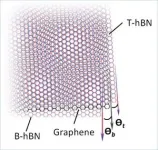
ELSE PRESS RELEASES FROM THIS DATE:
2023-08-29
A team of clinicians, exercise scientists, pharmaceutical scholars, ethicists and behavioral experts at the University of California, Irvine, outlined their concerns that the use of glucagon-like peptide-1 receptor agonists (GLP-1RAs) to treat childhood obesity and type 2 diabetes may have unintended and adverse consequences for children’s health.
The commentary, Unintended Consequences of Glucagon-like Peptide-1 Receptor Agonists Medication in Children and Adolescents – A Call to Action, was published as a perspective in the Journal of Clinical and Translational Science. The article was led by Dan M. Cooper, MD, distinguished professor in the Department of Pediatrics ...
2023-08-29
Playing a Mozart lullaby may help reduce the pain experienced by newborn babies undergoing a heel prick blood test, according to a randomised, blinded clinical trial involving 100 infants published in Pediatric Research.
Saminathan Anbalagan and colleagues measured the pain levels of newborn infants undergoing a heel prick blood test as part of routine screening for conditions such as jaundice and phenylketonuria (PKU) in New York City, New York, USA between April 2019 and February 2020. Infants were, on average, two days old and born at 39 gestational weeks, while 53% were male and 61% were Hispanic. As part of standard care, all infants ...
2023-08-29
High-quality sequencing of nearly the entire kākāpō population, funded through a Genomics Aotearoa project, is helping New Zealand to manage the health of this critically endangered species.
Not only is it already making a difference to kākāpō survival, but establishing sequencing methods to work with populations under threat is also likely to be the foundation for the future of endangered wildlife science in New Zealand and the rest of the world.
The state-of-the-art methods developed by Dr. Joseph Guhlin ...
2023-08-28
Transferring optical information in free space with large bandwidth and high transmission capacity has gained significant attention in various applications, such as remote sensing, underwater communication, and medical devices. Nevertheless, unpredictable, unknown phase perturbations or random diffusers within the optical path pose great challenges, limiting the high-fidelity transmission of optical data in free space. Adaptive optics presents a potential solution that can correct for random distortions ...
2023-08-28
Embargoed for release until 5:00 p.m. ET on Monday 28 August 2023
Annals of Internal Medicine Tip Sheet
@Annalsofim
Below please find summaries of new articles that will be published in the next issue of Annals of Internal Medicine. The summaries are not intended to substitute for the full articles as a source of information. This information is under strict embargo and by taking it into possession, media representatives are committing to the terms of the embargo not only on their own behalf, but also on behalf of the ...
2023-08-28
Imagine if you could build an electronic device made entirely of paper. A nontoxic, cost-effective and biodegradable alternative to silicon- and plastic-based components would be a game-changer for a planet quickly filling up with the “e-waste” of discarded gadgets and single-use sensors.
That’s the vision of Binghamton University Professor Seokheun (Sean) Choi. He’s worked for years creating better biobatteries that use bacteria or human sweat to generate energy. Some of those batteries have been paper-based, and now he hopes to apply that knowledge to ...
2023-08-28
DURHAM, N.C. – Researchers at Duke University have implemented a quantum-based method to observe a quantum effect in the way light-absorbing molecules interact with incoming photons. Known as a conical intersection, the effect puts limitations on the paths molecules can take to change between different configurations.
The observation method makes use of a quantum simulator, developed from research in quantum computing, and addresses a long-standing, fundamental question in chemistry critical to processes such as photosynthesis, vision and photocatalysis. It is also an example of ...
2023-08-28
Before heading to work each day, most people have spent the night dreaming. Studies show that on any given morning, about 40 percent of the working population recalls their dreams.
New research from the University of Notre Dame shows that when dreams are first recalled, people often draw connections between their dreams and waking lives, and the connections they draw alter how they think, feel and act at work.
“A Spillover Model of Dreams and Work Behavior: How Dream Meaning Ascription Promotes Awe and Employee Resilience” is forthcoming in the Academy of Management Journal from lead author Casher Belinda, assistant professor ...
2023-08-28
In the innovation economy, individuals with STEM PhDs are a critical source of human capital, with nearly 60 percent of PhDs in STEM fields— such as engineering, chemistry and biology—being employed outside of universities. These students are increasingly contributing to commercial science through patenting. New research from MIT Sloan School of Management and Copenhagen Business School investigated the training of these PhD students to better understand the pipeline and preparation of new inventors.
Conducted by Fiona Murray, MIT Sloan professor and associate dean for Innovation and Inclusion, ...
2023-08-28
Four new innovators recently joined Chain Reaction Innovations (CRI), the Lab-Embedded Entrepreneurship Program at the U.S. Department of Energy’s (DOE’s) Argonne National Laboratory, as part of the program’s seventh cohort.
Each innovator will collaborate with a host scientist at Argonne while embedded full-time at the laboratory. Innovators plan to develop clean energy startups that reduce greenhouse gas emissions and increase U.S. competitiveness in emerging energy technologies. The ...
LAST 30 PRESS RELEASES:
[Press-News.org] Golden rules for building atomic blocks


